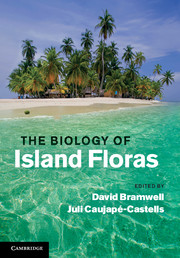Book contents
- Frontmatter
- Contents
- Contributors
- Preface
- 1 Introduction: islands and plants
- 2 The reproductive biology of island plants
- 3 Spatial methodologies in historical biogeography of islands
- 4 Origin and evolution of Hawaiian endemics: new patterns revealed by molecular phylogenetic studies
- 5 Origins and evolution of Galapagos endemic vascular plants
- 6 The plants of the Caribbean islands: a review of the biogeography, diversity and conservation of a storm-battered biodiversity hotspot
- 7 The biogeography of Madagascar palms
- 8 Evolution and biogeography of the flora of the Socotra archipelago (Yemen)
- 9 Biogeography and conservation of the flora of New Caledonia
- 10 Phytogeography and relationships of the Pitcairn Islands flora
- 11 Chromosomes and evolution in New Zealand endemic angiosperms and gymnosperms
- 12 Jesters, red queens, boomerangs and surfers: a molecular outlook on the diversity of the Canarian endemic flora
- 13 Endemism and evolution in Macaronesian and Mediterranean Limonium taxa
- 14 Dispersal, diversity and evolution of the Macaronesian cryptogamic floras
- 15 Invasive alien species and islands
- 16 Ecology, demography and conservation in the Galapagos Islands flora
- 17 New directions and challenges for the conservation of the flora of Madagascar
- 18 Climate change and island floras
- 19 Conservation status of endemic plants on Isla del Coco, Costa Rica: applying IUCN Red List criteria on a small island
- 20 Botanic gardens and the conservation of island floras
- 21 The hazardous future of island floras
- Index
- References
7 - The biogeography of Madagascar palms
Published online by Cambridge University Press: 07 October 2011
- Frontmatter
- Contents
- Contributors
- Preface
- 1 Introduction: islands and plants
- 2 The reproductive biology of island plants
- 3 Spatial methodologies in historical biogeography of islands
- 4 Origin and evolution of Hawaiian endemics: new patterns revealed by molecular phylogenetic studies
- 5 Origins and evolution of Galapagos endemic vascular plants
- 6 The plants of the Caribbean islands: a review of the biogeography, diversity and conservation of a storm-battered biodiversity hotspot
- 7 The biogeography of Madagascar palms
- 8 Evolution and biogeography of the flora of the Socotra archipelago (Yemen)
- 9 Biogeography and conservation of the flora of New Caledonia
- 10 Phytogeography and relationships of the Pitcairn Islands flora
- 11 Chromosomes and evolution in New Zealand endemic angiosperms and gymnosperms
- 12 Jesters, red queens, boomerangs and surfers: a molecular outlook on the diversity of the Canarian endemic flora
- 13 Endemism and evolution in Macaronesian and Mediterranean Limonium taxa
- 14 Dispersal, diversity and evolution of the Macaronesian cryptogamic floras
- 15 Invasive alien species and islands
- 16 Ecology, demography and conservation in the Galapagos Islands flora
- 17 New directions and challenges for the conservation of the flora of Madagascar
- 18 Climate change and island floras
- 19 Conservation status of endemic plants on Isla del Coco, Costa Rica: applying IUCN Red List criteria on a small island
- 20 Botanic gardens and the conservation of island floras
- 21 The hazardous future of island floras
- Index
- References
Summary
Madagascar has an extraordinary palm flora, diverse in species and evolutionary lines, a diversity that poses interesting evolutionary questions. The palms in Madagascar are in stark contrast to two other families of largely tropical monocotyledons, Zingiberaceae and Araceae, where the Madagascar representation is low in diversity despite being high in endemism. The contrast between the palm flora of Madagascar and that of the whole of continental Africa is remarkable, the former with over three times the number of species as the latter. With the discovery of yet more new palms in recent fieldwork the contrast is set to become even more striking. The phylogenetic relationships of Madagascar palms are complex, with groups variously linked to related taxa in differing parts of the tropical world, while the relationships of the most diverse group of Madagascar palms, subtribe Dysidinae, remain obscure.
- Type
- Chapter
- Information
- The Biology of Island Floras , pp. 179 - 196Publisher: Cambridge University PressPrint publication year: 2011
References
- 14
- Cited by



